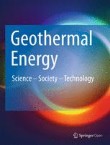Emerging technologies in ground-source heat pumps for low-carbon heating and cooling in buildings
Geothermal Energy
Edited by: Ning MAO, Zhenjun MA, Liang PU, Yiji LU, Hyunjun OH and Jiaming GONG
Published: 6 March 2024
Geothermal Fluid Properties at Extreme Conditions
Geothermal Energy
Edited by: Alper Baba, Harald Milsch and Simona Regenspurg
Published: 21 December 2023
On the future development of superhot and supercritical geothermal systems
Geothermal Energy
Edited by: Egbert Jolie, Hiroshi Asanuma and Guðmundur Ómar Friðleifsson
Published: 15 February 2021
From Exploration to Operation - Research Developments in Deep Geothermal Energy
Geothermal Energy
Edited by: Alexandra Kushnir and Markus Loewer
Published: 3 July 2019
Integrative Approaches in Deep Geothermal Science
Geothermal Energy
Edited by: Carola Meller and Emmanuel Gaucher
Published: 2 June 2018
View all article collections
